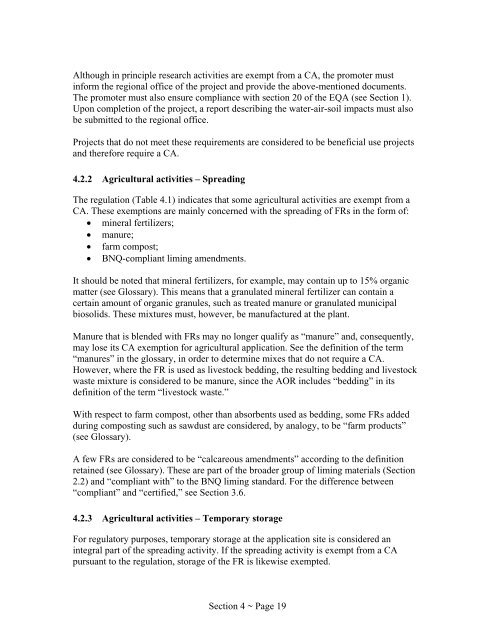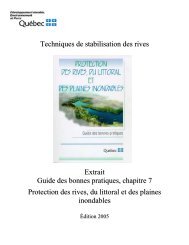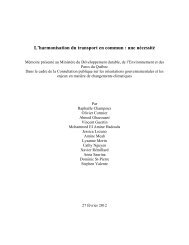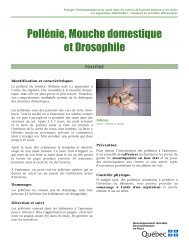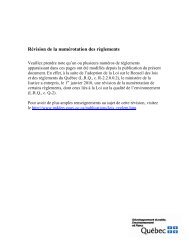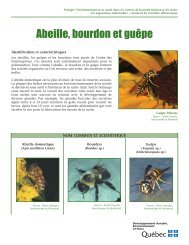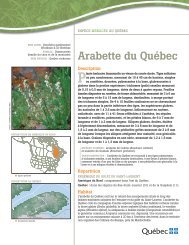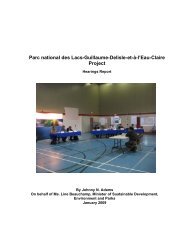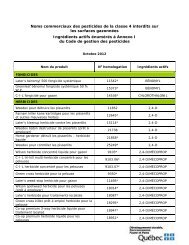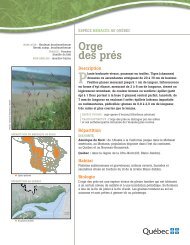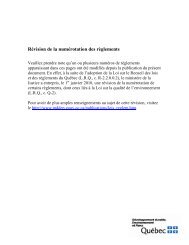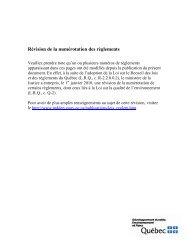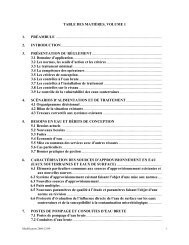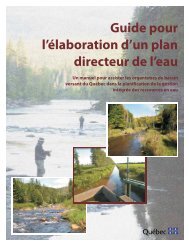Guidelines for the Beneficial Use of Fertilizing Residuals
Guidelines for the Beneficial Use of Fertilizing Residuals
Guidelines for the Beneficial Use of Fertilizing Residuals
You also want an ePaper? Increase the reach of your titles
YUMPU automatically turns print PDFs into web optimized ePapers that Google loves.
Although in principle research activities are exempt from a CA, <strong>the</strong> promoter must<br />
in<strong>for</strong>m <strong>the</strong> regional <strong>of</strong>fice <strong>of</strong> <strong>the</strong> project and provide <strong>the</strong> above-mentioned documents.<br />
The promoter must also ensure compliance with section 20 <strong>of</strong> <strong>the</strong> EQA (see Section 1).<br />
Upon completion <strong>of</strong> <strong>the</strong> project, a report describing <strong>the</strong> water-air-soil impacts must also<br />
be submitted to <strong>the</strong> regional <strong>of</strong>fice.<br />
Projects that do not meet <strong>the</strong>se requirements are considered to be beneficial use projects<br />
and <strong>the</strong>re<strong>for</strong>e require a CA.<br />
4.2.2 Agricultural activities – Spreading<br />
The regulation (Table 4.1) indicates that some agricultural activities are exempt from a<br />
CA. These exemptions are mainly concerned with <strong>the</strong> spreading <strong>of</strong> FRs in <strong>the</strong> <strong>for</strong>m <strong>of</strong>:<br />
• mineral fertilizers;<br />
• manure;<br />
• farm compost;<br />
• BNQ-compliant liming amendments.<br />
It should be noted that mineral fertilizers, <strong>for</strong> example, may contain up to 15% organic<br />
matter (see Glossary). This means that a granulated mineral fertilizer can contain a<br />
certain amount <strong>of</strong> organic granules, such as treated manure or granulated municipal<br />
biosolids. These mixtures must, however, be manufactured at <strong>the</strong> plant.<br />
Manure that is blended with FRs may no longer qualify as “manure” and, consequently,<br />
may lose its CA exemption <strong>for</strong> agricultural application. See <strong>the</strong> definition <strong>of</strong> <strong>the</strong> term<br />
“manures” in <strong>the</strong> glossary, in order to determine mixes that do not require a CA.<br />
However, where <strong>the</strong> FR is used as livestock bedding, <strong>the</strong> resulting bedding and livestock<br />
waste mixture is considered to be manure, since <strong>the</strong> AOR includes “bedding” in its<br />
definition <strong>of</strong> <strong>the</strong> term “livestock waste.”<br />
With respect to farm compost, o<strong>the</strong>r than absorbents used as bedding, some FRs added<br />
during composting such as sawdust are considered, by analogy, to be “farm products”<br />
(see Glossary).<br />
A few FRs are considered to be “calcareous amendments” according to <strong>the</strong> definition<br />
retained (see Glossary). These are part <strong>of</strong> <strong>the</strong> broader group <strong>of</strong> liming materials (Section<br />
2.2) and “compliant with” to <strong>the</strong> BNQ liming standard. For <strong>the</strong> difference between<br />
“compliant” and “certified,” see Section 3.6.<br />
4.2.3 Agricultural activities – Temporary storage<br />
For regulatory purposes, temporary storage at <strong>the</strong> application site is considered an<br />
integral part <strong>of</strong> <strong>the</strong> spreading activity. If <strong>the</strong> spreading activity is exempt from a CA<br />
pursuant to <strong>the</strong> regulation, storage <strong>of</strong> <strong>the</strong> FR is likewise exempted.<br />
Section 4 ~ Page 19


